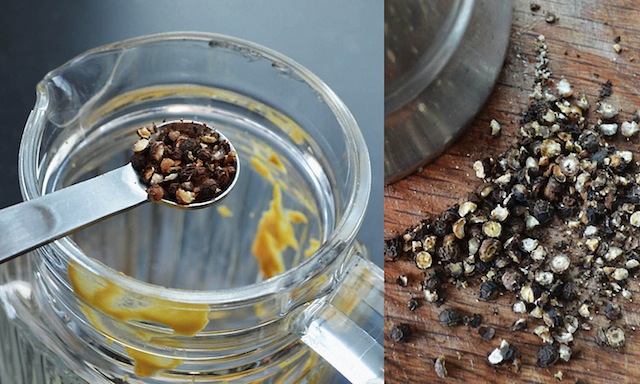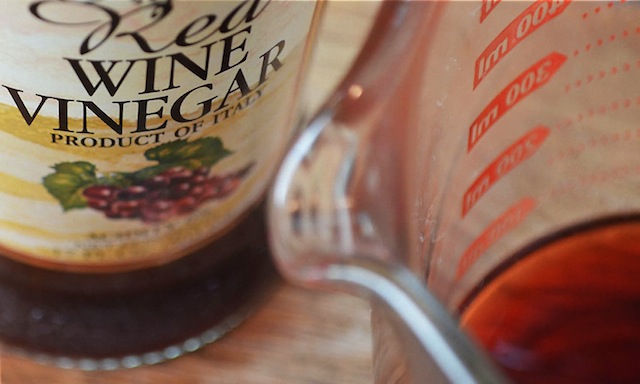12/05/13 • MUSTARD VINAIGRETTE
From Julia and Jacques: Cooking at Home

I’ve gone back-and-forth about sharing this particular recipe with all of you—not because I don’t believe it’s one everyone should know about, but because it’s for salad dressing… and somehow that just seemed too minor to warrant its own posting. Except I know from experience how valuable the right salad dressing recipe can be. One or two good ones are all you need for a lifetime of cooking, and once you find the formula that suits you, it’s a little like inheriting your grandmother’s cast-iron skillet; you guard it with your life and give it lots of love. At least that’s how I feel about this recipe, one I’ve come to view as my secret meal-planning weapon, since no matter how uncertain I may be about the success of whatever else I’m cooking, I always know the salad will be a hit. And by “hit,” I don’t just mean devoured, but singled out (this as recently as last night, when completely unprompted and after having eaten it for years, Alfredo announced, “God, your salad dressing is good!”). Little surprise then that the recipe request I get most often from those seated around our table is for my salad dressing. So here it is: a minor player, perhaps, but a critical one in the planning of any meal.
But don’t just take my word for it—Jacques Pepin himself has given the recipe his seal of approval, presenting it as his own go-to vinaigrette in Julia and Jacques: Cooking at Home (one of my all-time favorite cookbooks). And, like any salad dressing recipe, the formula is there for you to experiment with as you like, dialing up or down the acidity and swapping out vinegars and oils with different flavor profiles. (Pepin cautions, however, that if you’re adding an oil or vinegar with a particularly strong flavor, like balsamic vinegar, you’ll want to use only a small amount, mixing it with the standard vinegar or oil listed in the recipe so as to avoid overpowering the greens). That said, in my many years of making this dressing I’ve never found any reason to alter it, unless I suddenly discovered I’d run out of red wine vinegar and was forced to use one of the alternatives lurking in the cabinet. In other words, from my perspective it’s the perfect combination of flavors, just as is.
One reason for that is the presence of two tablespoons of Dijon mustard, which gives the vinaigrette the ideal acidic kick (you can also use white-wine vinegar, though I generally go for the red-wine variety). And, of course, it’s simple (this is salad dressing, after all), requiring nothing more than placing the above two ingredients in a re-sealable glass jar along with 2 teaspoons of chopped garlic, a ½ teaspoon salt, a ¼ teaspoon of freshly ground black pepper, and a cup of olive oil, giving the mixture a vigorous shake, and presto: the answer to your salad dressing dreams. And for those of you made anxious by the presence of garlic here, have no fear. The tang of the various other ingredients present in the mixture has a way of mellowing the sharp (and to some, unpleasant) quality of the garlic—you can taste it, but it’s subtle. Mellow, too.
The other thing worth mentioning about this vinaigrette is that its big flavor makes it the ideal accompaniment for meat or other hearty dishes. As such, it’s one I tend to use frequently in cold weather months, as opposed to the warmer ones when I typically want something lighter. And the recipe produces about 1½ cups of dressing, which in my experience is enough to get me through at least three big salads. (The dressing will keep in the fridge for up to two weeks, though if you plan to store it that long consider adding the garlic as you go, since it can lose some of its zip and turn bitter over time.) All of which is good news for the holiday season, as well as for the weeks following, when so many of us will be atoning for our culinary sins with a salad-only diet. Thanks to this dressing, that’s something you can look forward to.
Ingredients:
—2 tsp chopped garlic (shallot can be substituted)
—2 tbs Dijon-style mustard
—1/2 tsp salt
—1/4 tsp freshly ground black pepper
—1/4 cup red- or white-wine vinegar
—1 cup extra-virgin olive oil or peanut oil, or a mixture of the two
Special equipment:
—A 12-ounce glass jar with a screw-top lid
Note #1: Other oils or vinegars can be substituted, though if you’re using a powerfully flvored one like balsamic vinegar, it’s recommended to mix a small amount with the standard vinegar or oil option listed in the recipe.
Note #2: The vinegar will keep in the fridge for up to two-weeks, though if you’re planning to store it that long, it’s best to add the garlic (or shallot, if using) as you go, as both can lose their flavor and turn bitter over time.
Directions:
—Put all of the ingredients in the jar, screw on the lid, and shake well. Taste and adjust seasoning, adding more oil or vinegar, as you like.
—Store in refrigerator up to 2 weeks, and shake to blend before using.
Makes about 1½ cups




















